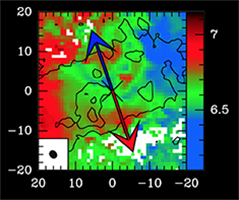Angular momentum profiles of Class 0 protostellar envelopes
Gaudel M.; Maury A.J.; Belloche A. & CALYPSO collab.
JANUARY 2020In the framework of the IRAM CALYPSO survey, we obtained observations of the dense gas kinematics that we used to quantify the amount and distribution of specific angular momentum at all scales in collapsing-rotating Class 0 protostellar envelopes. We used the high dynamic range C18O (2−1) and N2H+(1−0) datasets to produce centroid velocity maps and probe therotational motions in the sample of 12 envelopes from scales∼50 to∼5000 au.

We identify
differential rotation
motions at scales.1600 au in
11 out of the 12
protostellar envelopes of
our sample by measuring the
velocity gradient along the
equatorial axis, which we
fit with a power-law model
v∝r^α. This suggests that
coherent motions dominate the
kinematics in the inner
protostellar envelopes. The
radial distributions of
specific angular momentum in
the CALYPSO sample suggest
the following two distinct
regimes within protostellar
envelopes: from the largest
scales probed, the specific
angular momentum
decreases with decreasing
radius as j∝r^1.6, down
to∼1600 au and then tends to
become relatively constant
around a value ∼6×10^−4 km s−1pc down
to∼50 au. The values of
specific angular momentum
measured in the inner
Class 0 envelopes suggest
that material
directly involved in the star
formation process (<1600 au)
has a specific angular
momentum on the same order
of magnitude as what is
inferred in small T-Tauri
disks. Thus, disk formation appears to be a direct consequence of
angular momentum conservation during the collapse. Our analysis reveals
a dispersion of the directions of velocity gradients at envelope
scales >1600 au, suggesting that these gradients may not be directly
related to rotational motions of the envelopes. We conclude that the
specific angular momentumobserved at these scales could find its
origin in other mechanisms, such as core-forming motions (infall,
turbulence), or trace an imprint of the initial conditions for the
formation of protostellar cores.